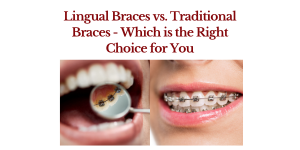People often consider metal brackets and wires the go-to solution for straightening teeth.
However, advancements in orthodontics have introduced several options, one of which includes lingual braces.
But how do these compare to traditional braces?
If you’re considering orthodontic treatment and wondering which type is right for you, it’s important to explore your options.
We’ll now break down the differences between lingual and traditional braces to help you decide.
What Are Lingual Braces?
They are an ingenious alternative to traditional metal braces. Unlike the metal brackets on the front of your teeth, they are attached to the backside, making them virtually invisible.
They function similarly to traditional braces by applying pressure to move teeth into proper alignment, but they do so more discreetly.
If you’re looking for a way to straighten your teeth without anyone noticing, lingual braces might be the answer.
How Do Traditional Braces Work?
Traditional braces have been around for decades and remain one of the most common methods of teeth straightening.
These braces consist of metal brackets affixed to the front of your teeth, connected by wires that gradually tighten to move your teeth into place.
They are highly effective in correcting many dental issues, from simple alignment problems to more complex cases like overbites, underbites, and severe crowding.
Traditional braces are prominent, which can be a downside for adults or teens who feel self-conscious about their appearance.
However, they offer excellent control over tooth movement and often produce faster results than other options.
Aesthetic Considerations: Lingual vs. Traditional
One of the biggest reasons people choose lingual braces is aesthetics. If you value a subtle appearance, lingual braces are likely a better fit for you.
Since they sit behind the teeth, they’re invisible to others.
This is a popular choice among adults who prefer a discreet treatment option or those in careers where appearance is important.
In contrast, traditional braces are highly visible due to the metal brackets on the front of your teeth.
While clear or ceramic brackets are an option for those who want a more subtle look, they still won’t offer the same level of invisibility as lingual braces.
Comfort and Maintenance
Lingual braces present a unique set of challenges regarding comfort.
Since the brackets are placed on the inside of the teeth, they can rub against your tongue and cause discomfort, especially in the early stages of treatment.
Speech may also be temporarily affected as your mouth adjusts to the new hardware.
On the other hand, traditional braces tend to be more comfortable because your mouth is more accustomed to objects on the outer surface of your teeth.
However, traditional braces can irritate the inside of your cheeks and lips, especially when you’re first getting used to them.
When it comes to upkeep, both options require good oral hygiene.
However, cleaning around lingual braces may be more challenging due to their placement.
Your family dentist will likely recommend specialized tools, such as a water flosser or interdental brush, to keep your braces clean.
Effectiveness and Treatment Time
Both lingual and traditional braces effectively correct various dental issues.
However, traditional braces may have the edge in complex cases.
Since the orthodontist has more control over tooth movement with traditional braces, treatment may progress faster.
Lingual braces can treat most of the same issues, but there may be a longer adjustment period, especially for more severe cases.
Your family dentist or orthodontist can help determine which option works better for your needs.
Which Option Is Right for You?
Deciding between lingual and traditional braces ultimately comes down to your lifestyle, budget, and the complexity of your dental issues.
If aesthetics are your primary concern and you’re looking for a subtle, invisible option, lingual braces might be the better choice.
However, traditional braces might be a better fit if you’re more concerned about effectiveness and are willing to live with visible braces for a shorter treatment time.
Consulting with your family dentist is essential to understand the best option for your unique needs.
They can evaluate your case and help guide you toward the treatment that will give you the best results.
Conclusion
When considering orthodontic treatment, it’s important to weigh all the factors carefully. Both lingual and traditional braces have pros and cons, and what works best for you will depend on your priorities. Whether you’re more concerned about aesthetics or comfort, knowing what lingual braces are and how they compare to traditional braces will help you make an informed decision.

